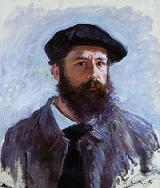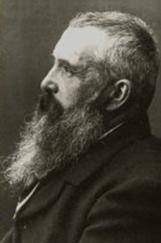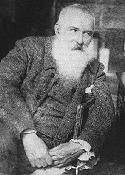Early Training
A pivotal experience occurred in 1856 when Monet became friends with Eugene Boudin, a landscape painter famous for his scenes of northern French coastal towns. Boudin encouraged him to paint outdoors, and this plein air technique changed Monet's concept of how art could be created: "It was as if a veil was torn from my eyes; I had understood. I grasped what painting could be."
Despite being rejected for a scholarship, in 1859 Monet moved to Paris to study with help from his family. However, instead of choosing the more customary career path of a Salon painter, by enrolling at the Ecole des Beaux-Arts, Monet attended the Académie Suisse, where he met fellow artist Camille Pissarro.
Mature Period

Obliged to serve in the military, in 1861 Monet was sent to Algiers. Like Eugene Delacroix before him, the north African environment stimulated Monet and affected his artistic and personal outlook. Coming home to Le Havre after his service, his "final education of the eye" was provided by the Dutch landscape and marine artist Johan Jongkind. Following this, Monet again left for Paris, attending the studio of Swiss artist Charles Gleyre, which included such students - and future Impressionists - as Pierre-Auguste Renoir, Frederic Bazille and Alfred Sisley.
In 1865, the Paris Salon accepted two of Monet's seascapes for exhibition. However, the artist was feeling confined by working in a studio, preferring his earlier experience of painting in nature, so he moved just outside Paris to the edge of the Fontainebleau forest. Using his future wife, Camille Doncieux, as his sole model, his ambitiously large Women in the Garden(1866-67) was a culmination of the ideas and themes in his earlier work. Monet was hopeful that the work would be included in the Paris Salon, but his style kept him at odds with the jurors and the picture was refused, leaving the artist devastated. The official salon at this time still valued Romanticism. (In 1921, to assuage the 50-year-old insult, Monet made the French government purchase the painting for the enormous sum of 200,000 francs.)
To escape the Franco-Prussian War in 1870, Monet took refuge in London, producing many scenes such as Westminster Bridge (1871). His wife and their new baby boy joined him. He visited London museums and saw the works of John Constable and J.M.W. Turner, whose romantic naturalism clearly influenced his use of light. Most importantly, he met Paul Durand-Ruel, who ran a new modern art gallery on Bond Street. Durand-Ruel became a major supporter of Monet and Pissarro, and later Renoir, Degas, and other French Impressionists.

Returning to France after the war, Monet settled his family in Argenteuil, a suburb of Paris along the Seine River. Over the next six years he developed his style and documented the changes in the growing town in over 150 canvases. His presence also attracted Parisian friends including Renoir and Manet. While each influenced the other in significant ways, Monet had won Manet over to plein air painting by 1874.
In a continued effort to protest the salon system, Monet and his friends organized their own exhibition in 1873, held in the vacated studio of photographer and caricaturist Felix Nadar. This became known as the first Impressionist exhibition. These artists, including Renoir, Degas, and Pissarro, were the first artists to collectively respond to the changes in their city. The modernization of Paris was evident in the wider boulevards needed to accommodate the expanding fashions of public life and growing traffic of consumerism. Not only was their subject matter new, but the way they portrayed this reality was unique as well. Intuitive feeling and the essence of spontaneity, of the moment, were impressed upon the canvas. It was through the 1873 work Impression, Sunrise that Monet inadvertently gave the movement its name, although that name was actually initially used by writers to criticize these types of works.
While Monet's upbringing was rather middle class, his extravagant tastes led him to live much of his life in varying degrees of poverty and debt. His paintings were not a decent source of income and he often had to borrow money from his friends. After receiving several commissions throughout the 1870s, Monet enjoyed some financial success, but was in dire straits by the end of the decade. When his wife Camille died in 1879, there was a change in Monet's work, focusing more on the flux of experiential time and the mediating effects of atmosphere and personality on subject matter.
The next two decades of Monet's life and work were characterized by constant travel. He visited Norway and Venice, and made several journeys to London and around France. Monet was less concerned with modernity in his works and more with atmosphere and environment. It was at this stage that he hit upon the type of paintings for which he is perhaps best known. His series of grainstacks, painted at different times throughout the day, received critical acclaim from opinion-makers, buyers, and the public when exhibited at Durand-Ruel's gallery in May 1891. He then turned his sights to Rouen Cathedral, making similar studies of the effects of changing mood, light, and atmosphere on its facade at different times of the day. The results were over 40 canvases of brilliant, slightly exaggerated colors that formed a visual record of accumulated perceptions.
Late Years and Death

Ultimately, Monet preferred to be alone with nature, creating his paintings rather than participating in theoretical or critical battles within the artistic and cultural scene of Paris. After his 1908 Venetian excursion, he settled for the remainder of his life at his estate in Giverny. The year 1911 saw the death of his second wife, Alice, followed by his son, Jean. Shattered by these deaths, the ragings of the First World War, and even a cataract forming over one of his eyes, Monet essentially ceased to paint. Finally, his friend Georges Clemenceau lifted him out of his mourning by encouraging him to create his water garden series, of which the Water Lilies (1918) is a part.
The property at Giverny was Monet's primary inspiration for the last three decades of his life. He created a Japanese garden for contemplation and relaxation, making a pond filled with water lilies with an arched bridge. He conceived a continuous sequence of waterscapes situated in an oval salon as a world within the world. A new studio with a glass wall facing the garden was built for this purpose, and despite having cataracts now in both eyes, Monet was able to move a portable easel around to different places within the studio to capture the ever-changing light and perspective of his water lilies. Concentrating on the pond itself, his all-over compositions allowed the viewer to feel as if they were within the water surrounded by the foliage. He continued to work on his water paintings right up until the end of his life.
Legacy
Monet's extraordinarily long life and large artistic output befit the enormity of his contemporary popularity. Impressionism, for which he is a pillar, continues to be one of the most reproduced styles of art for popular consumption in the form of calendars, postcards, and posters. Additionally, his paintings command top prices at auctions. Monet's work is in every major museum worldwide and continues to be sought after. While there have been major internationally touring retrospectives of his work, even the presence of one Monet painting can anchor an entire exhibition for the audience. The impact of his experiments with changing mood and light on static surfaces can be seen in most major artistic movements of the early twentieth century.